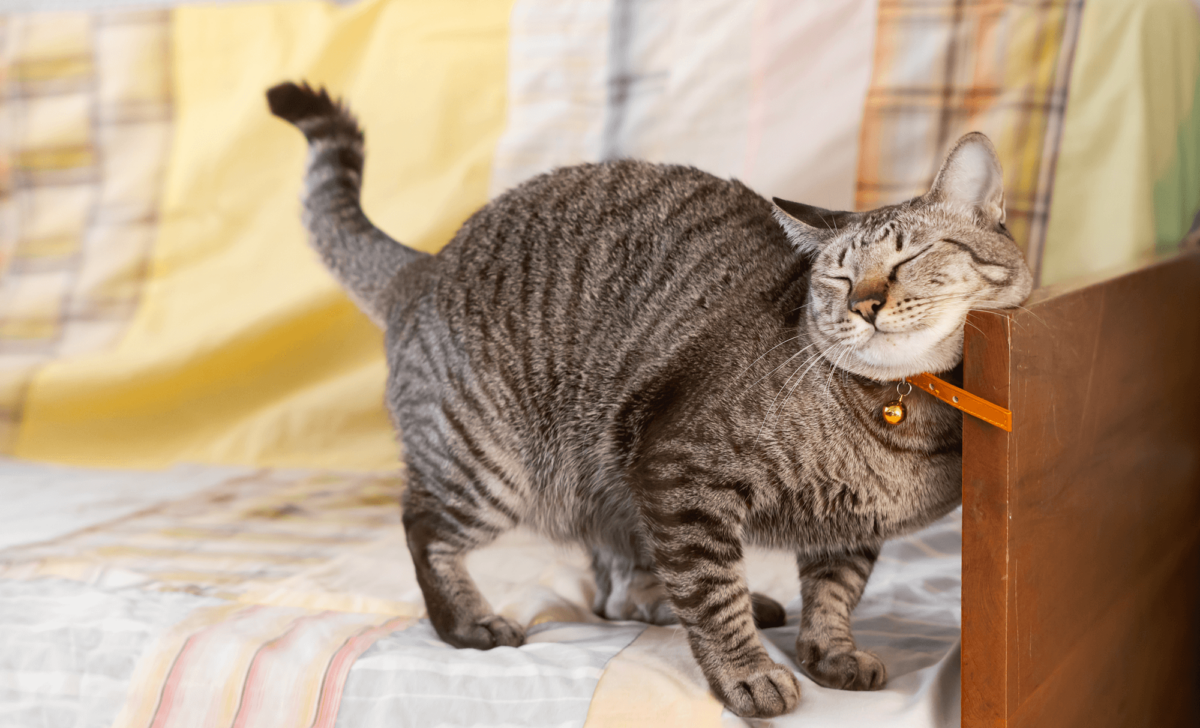Pheromones play a significant role in the social behavior of many species, including dogs, cats, and possibly humans. Although our pets cannot consciously control pheromone secretion, the chemicals can influence how they feel in certain situations and with whom they form social bonds. Dogs and cats rely heavily on pheromone communication, using their refined sense of smell and a specialized nasal organ to detect pheromone messages.
Scientists have studied several pheromone types in pets, which has led to the creation of synthetic versions designed to promote calm, relaxed behavior. These pheromones are now widely available and, because they don’t cause harmful side effects, they are an essential tool for Fear Free Certified® Veterinary Professionals and pet owners to reduce fear, anxiety, and stress in pets at home and beyond.
Understanding pheromones in dogs and cats
Animals use pheromones, which are chemicals secreted from oil glands and detected through the vomeronasal organ in the nasal cavity, to communicate with others of their species. These molecules can trigger specific brain responses and influence various behaviors, including mating, marking, and social bonding.
Dogs and cats produce several pheromone types for varied purposes, including:
- Maternal pheromones — Emitted by lactating females to soothe nursing puppies and kittens
- Appeasement pheromones — Used to signal a non-threatening, friendly gesture
- Sex pheromones — Influence reproductive behavior and mate choice
- Fear and stress hormones — Impact how dogs and cats respond when they come in contact with fear pheromones left by another dog or cat
How synthetic pheromones work to calm pets
Synthetic pheromones are lab-created versions of well-studied pheromone chemical compounds. Currently, synthetic pheromone manufacturers are most interested in maternal and appeasing pheromones, which are thought to create a sense of calm during stressful events and can enhance bond formation or reduce stressful pet interactions.
The synthetic versions of these chemicals most often include analogs of dog appeasing pheromone, cat maternal pheromone, and cat facial pheromone, which is released when your cat rubs their cheeks on surfaces around the home. These bind to receptors in the nose and brain, which triggers neural pathways that induce feelings of calm, familiarity, and belonging. Synthetic pheromones, which are available in various forms, including room diffusers, sprays, and wearable collars, are unlikely to cause adverse reactions, and are generally considered safe.
Pheromones can effectively reduce stress and anxiety in dogs and cats experiencing separation anxiety or noise phobias, during veterinary visits, or even while introducing new household pets. While synthetic pheromones are a valuable tool in our anti-anxiety toolbox, they are best used in conjunction with other methods as part of an overall behavioral treatment plan.
Pheromones for pets at home
Providing your pet with pheromones at home may help smooth out stressful transitions, such as moving to a new home or acquiring a new pet, help reduce inter-pet conflict, and reduce anxiety, which often contributes to problem behaviors such as house soiling or excessive scratching. The goal of pheromone use is to create a sense of ease and promote a Fear Free home environment.
For maximum effect, provide steady pheromone exposure with wearable collars or room diffusers. Consult your Fear Free Certified Veterinarian or a qualified animal behavior professional to learn which products may work best for your pet and how to combine pheromones with behavior modification techniques.
Pheromones for veterinary visits
Using synthetic pheromones in Fear Free Certified Veterinary Practices helps create a welcoming atmosphere, and diffusers or sprays used in waiting areas, exam rooms, or on veterinary team members can help pets relax. This technique helps prevent negative veterinary experiences, which can create lasting fears that prevent pets from receiving necessary veterinary care. Pet owners can also use pheromones in carriers or spray them on a pet’s collar or bandana to reduce travel stress. Although pheromone products are safe, they are not designed to be sprayed directly on a pet.
Used alone, pheromone products can provide everyday behavior support. For anxious or stressed pets or those with difficult behaviors, pheromones are best combined with other therapies. Anxiety wraps, species-specific music, supplements, medications, and Fear Free handling methods can complement pheromones to reduce fear, anxiety, and stress (FAS) and improve your pet’s wellbeing.
Contact your Fear Free Certified Veterinarian to discuss pheromone use and learn more about bSerene calming diffusers, collars, and sprays, or other products that may be appropriate for your pet.
Brought to you by our friends at bSerene.

This article was reviewed/edited by board-certified veterinary behaviorist Dr. Kenneth Martin and/or veterinary technician specialist in behavior Debbie Martin, LVT.
Want to learn more about Fear Free? Sign up for our newsletter to stay in the loop on upcoming events, specials, courses, and more by clicking here.








